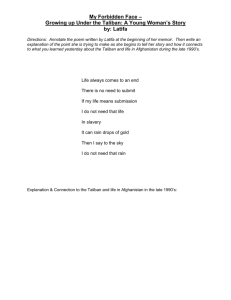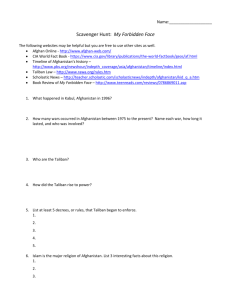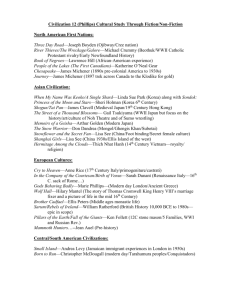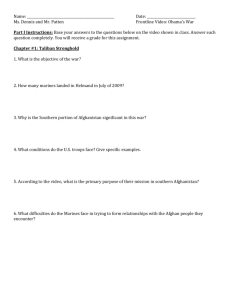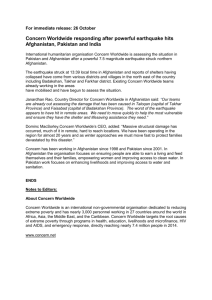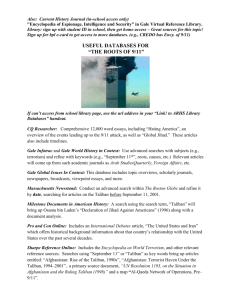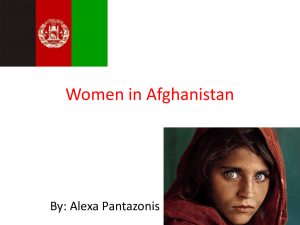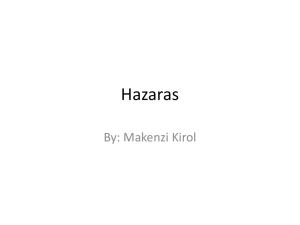US Withdrawal from Afghanistan
advertisement
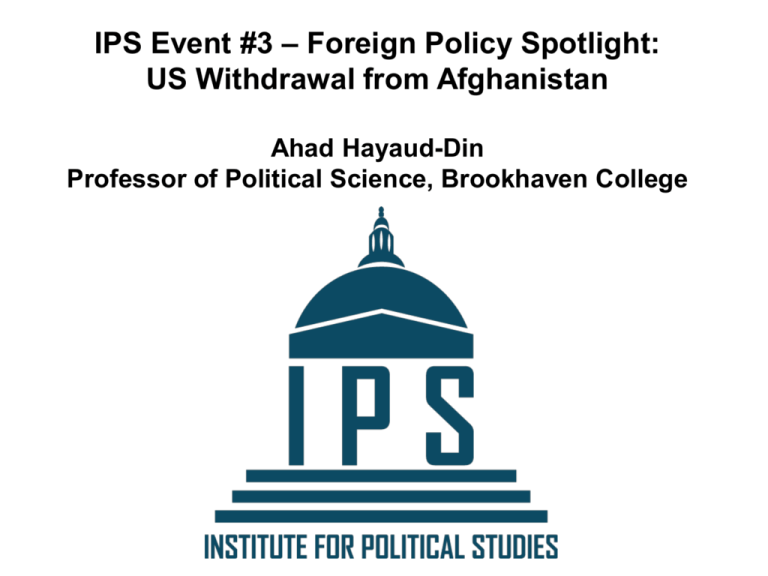
IPS Event #3 – Foreign Policy Spotlight: US Withdrawal from Afghanistan Ahad Hayaud-Din Professor of Political Science, Brookhaven College Country Profile Capital: Kabul Area: 252K square miles (slightly smaller than Texas) Population: 31 Million (July 2006 estimate) GDP per capita: purchasing power is $800 per person annually (2004 estimate) = $2.19 per day. Economy: Marginalized and underdeveloped, over 80% of the labor force is employed in agriculture. Language: Most Afghans are bilingual Dari (official language) 50% Pashtu (official language) 35% Turkic languages 11% 2014 UN HDI Score 0.468 ranks 169 out of 187. That means living conditions are #19 on the list of the 20 worst countries on the planet. Unique Geography Located in Central Asia, bordered by six countries: China* Iran** Pakistan* Tajikistan Turkmenistan Uzbekistan *Indicates states with nuclear weapons ** Not confirmed Ethnic Composition 42% Pashtun: largest ethnic group, mostly farmers and Sunni Muslims 27% Tajik: live mostly in the northeast, second largest ethnic group, mostly Sunni Muslims 9% Uzbek: live mostly along the northern border, mostly Sunni Muslims 9% Hazara: live in the Hindu Kush mountains, primarily Shiite Muslims 13% Others: Aimak: a farming and herding tribe in the west, mostly Sunni Muslims Turkmen and Kirghiz: nomadic herders and craftsmen, mostly Sunni Muslims Baluchi: nomadic tribe living in the southern deserts, Sunni Muslims Pashtunwali – The Honor Code Jirga – Conflict Resolution Badal - Revenge Melmastia – Hospitality Nanawatay - Asylum Tor – Sexual Deviance Ancient Political History Afghanistan's location along the Silk/Spice Road meant that it served as an important link between east and west throughout history. This location, however, has meant significant intervention from outsiders. Afghanistan is known as “the Graveyard of Empires.” The Great Game Great Britain & Russia fought a series of wars over Afghanistan during the 18th & 19th centuries as each side wanted to expand its empire. The Durand Line Britain determined boundaries that did not take ethnic populations into account. In 1893, the Durand Line cut through Pashtun tribal areas and villages. The agreement caused disputes between the governments of Afghanistan and British India and later between Afghanistan and Pakistan. In 1947, Britain ended colonial rule in India and formed the country of Pakistan (with a Muslim majority). Border conflicts persist over FATA region of NW Pakistan (AKA: No Man’s Land). th 20 Century Political History Afghanistan began trade relationship with the USSR in the 1940s and viewed the Soviets as important source of protection. Internal conflicts in Afghanistan led to the Soviets’ invasion (1979) both to stabilize Afghanistan (under the Brezhnev Doctrine) and once again, to pursue geo-political interests (naval interests). From 1979-1989, Afghanistan became a battleground of the Cold War between the US and USSR (with the U.S. supporting the Afghan resistance of the Soviets’ invasion). Afghan-Soviet War The Mujahideen declared a holy war against the “godless” Soviet invaders. CIA and RDFs trained and equipped the freedom fighters (plausible deniability). Soviet occupation took a heavy toll on Afghans because of the depopulation strategy. Most civilians fled to bordering countries (largest refugee migration in history). Results of the Soviet Conflict Soviet withdrawal (1989) left country in a power vacuum. Infrastructure, economy, education, health systems totally destroyed. Civil war broke out as rival tribes and regional groups fought for power. The Soviet Army withdrawing from Afghanistan in 1989 over the Friendship Bridge. Some experts say this moment was the end of the Cold War. Rise of the Taliban In 1996, the Taliban seize power by capturing Kandahar and Kabul. They were determined to end lawlessness and restore the importance of Islam by imposing a strict interpretation of Shari’a law. Taliban initially well received, had support of US, Pakistan, and Saudi Arabia. US hoped for construction of the ARAMCO oil pipeline. Effects of Taliban Rule Limited women's rights, banned girls from attending school and committed crimes against humanity (example: mutilation). Banned music, sports, television, movies, dancing, playing cards, and kite flying. By 2000, the Taliban were losing control and forcibly recruiting young men and forging an alliance with Al-Queda. Taliban Attract Global Ire Al-Qaeda allowed to freely operate within the country after attacking two US Embassies in Africa and the USS Cole. 8/20/1998 Pres. Clinton ordered strikes of 75 cruise missiles, missed OBL by 1 hour. In 2001, the Taliban destroyed the sacred Buddhas of Bamiyan (in Afghanistan). The statues were over 1500 years old and listed as a World Heritage Site by the UN. 21st Century and the US Intervention US policy shifts to direct intervention after 9/11/2001. History shows this was not a good idea. Timeline of events (1999 - Present). Today it is a NATO operation…why not UN? NATO - International Security Assistance Force (ISAF) FATA – Federally Administered Tribal Area AF-PAK Policy Issues Pakistani ISI and military forces deeply involved with Afghan politics. “Strategic Depth” is Pakistan’s official nuclear combat policy. Ironically, it worked the other way around for Taliban and Al-Queda. Nearly half of Afghanistan’s population was inside of Pakistan. FATA border issues have persisted several generations and will continue. December 2014 and the Current US Withdrawal Plan 2009: New President Obama surges troop level from 36k to 99k. 2010: London Conference targets 2011 for US withdrawal. 2012: Chicago and Tokyo Conferences target 2014 for US withdrawal. 9/30/2014: new Bilateral Security Agreement (BSA) expects NATO/ISAF will provide artillery and air power until 2017. ISAF will eventually morph into a counter-terrorism training force with 6 bases (plus 9 secret bases for US Special Operations units). 1/1/2015, BSA goes into effect and will remain in force "until the end of 2024 and beyond" unless it is terminated by either side with two years' notice. Skepticism from Policy Hawks • Spring is the fighting season; 2015 will provide a forecast. Special Inspector General for Afghanistan Reconstruction (SIGAR) reports the country is more unstable than ever. • US Army General John Campell, the top commander of the international coalition has suggested waiting until 2016 to continue training the Afghan troops. • Commander of US Forces, General Joseph Dunford Interview. • Several senior government officials and many top experts went on record to state the current plans will lead to a more disastrous situation than Iraq. • What happened to the Neo-Marshall plan? We remain engaged with England, Germany, Japan, and Korea decades later. Conclusions and Future Considerations Afghanistan will face a number of significant challenges as it tries to rebuild after 3 decades of war. Some of these challenges include: Unstable government and widespread political corruption Justice, liberty and equality as obstacles toward building a civic/democratic society, the role of women being critical Poverty/economic insecurity and proliferation of poppy (opium) industry “Hungry people don’t care about voting.” Infrastructure (education, healthcare, electricity, communications, roads, etc.) The Taliban and affiliated groups, Wahhabism and now ISIS ISIS will be the topic of our next foreign policy spotlight on April 22, 2015. I hope to see you then! Questions? Contact information: Ahad Hayaud-Din Professor and Department Lead, Political Science/Government Director, Institute for Political Studies (IPS) at Brookhaven College Facebook: https://www.facebook.com/BrookhavenIPS Twitter: https://twitter.com/IPS_BC E-mail: adin@dcccd.edu
